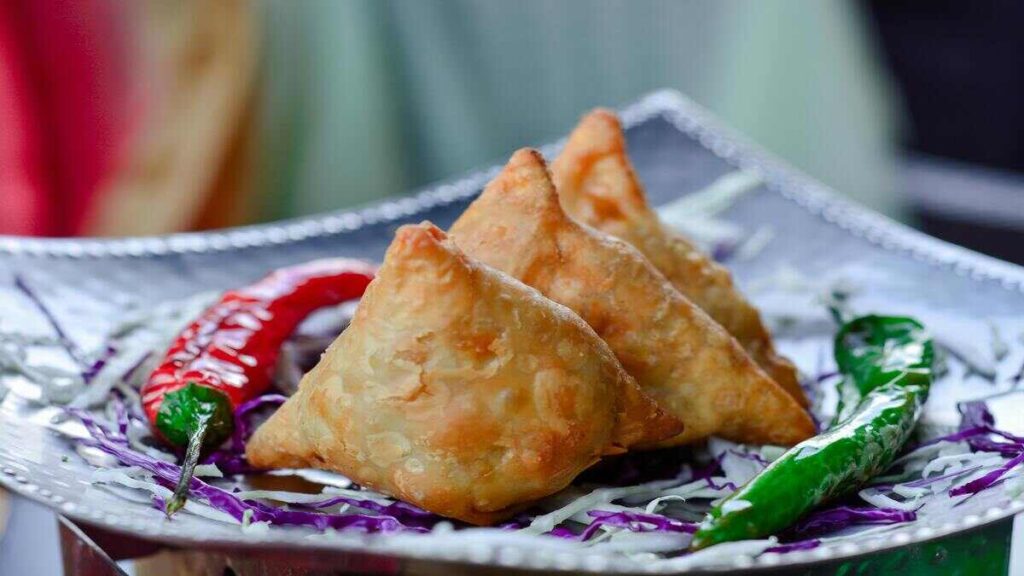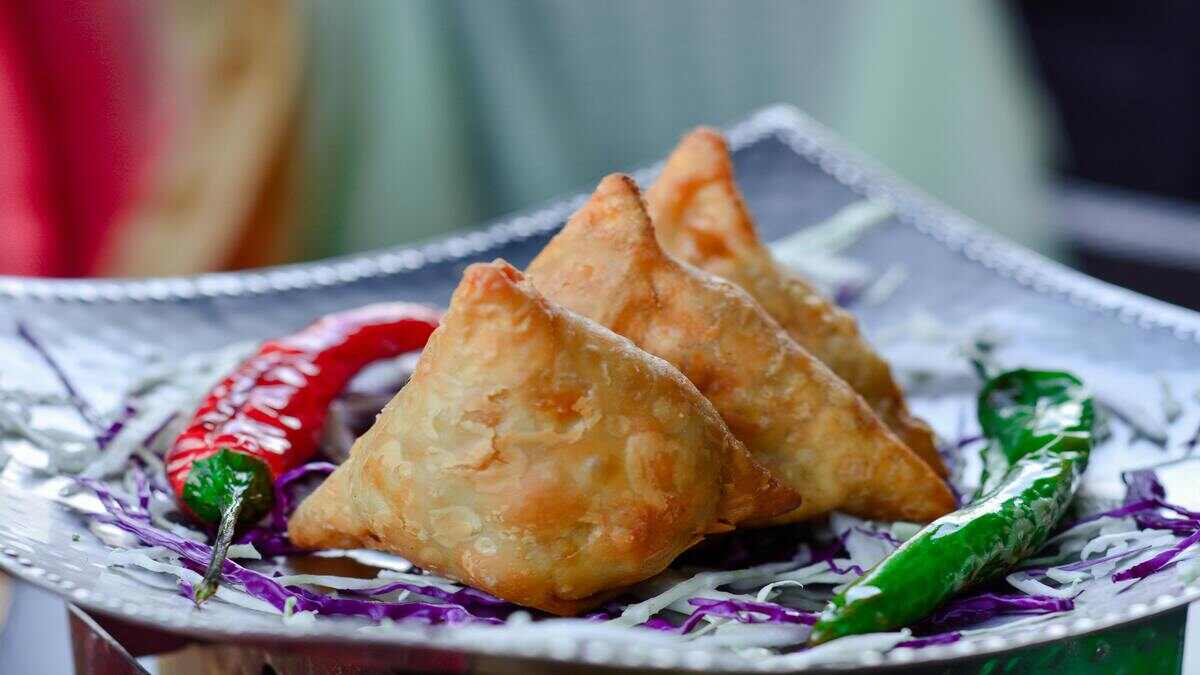There’s something universally loved about samosas—those crispy, golden pockets filled with a savory mixture of vegetables and spices. Whether you’re snacking at home, enjoying them at a party, or indulging in street food while traveling, Vegetable Samosas Recipe are a go-to comfort food for many. But what makes these little triangular treats so irresistible? In this guide, we’ll explore everything you need to know about Vegetable Samosas: from their origin and ingredients to the step-by-step process of preparing them at home. Plus, we’ll dive into their health benefits and the best ways to serve them, all while keeping it fun and informative!
What is a Vegetable Samosas Recipe?
Vegetable Samosas Recipe is a popular Indian snack made from a crispy, deep-fried pastry shell filled with a spiced mixture of vegetables. The classic filling typically includes potatoes, peas, carrots, onions, and sometimes beans or cauliflower, all seasoned with a blend of aromatic spices like cumin, coriander, and turmeric. The triangular shape of the samosa is iconic, and they are usually enjoyed with chutneys such as mint or tamarind.
Samosas come in various versions, but the vegetable-filled variety is favored by vegetarians and anyone looking for a flavorful snack without meat. They are a staple in Indian cuisine and have made their way across the globe, becoming a beloved snack in many cultures. Whether they’re served at a wedding, offered at a local restaurant, or prepared at home, these crispy, spicy delights are always a crowd-pleaser.

The Origins of Vegetable Samosas Recipe
The history of samosas stretches back several centuries and is believed to have originated in the Middle East or Central Asia. They were introduced to the Indian subcontinent around the 10th century, likely by traders or conquerors who brought the concept of stuffed pastries with them. Over time, samosas became a part of Indian cuisine, where they evolved into various regional varieties.
In India, the vegetable samosa is particularly popular because of the country’s large vegetarian population and the abundance of vegetables grown across the region. The spiced potato filling became a favorite due to its accessibility, affordability, and ability to cater to both vegetarians and non-vegetarians. Today, the samosa is a global snack enjoyed by people of all cultures.
Ingredients for Vegetable Samosas Recipe
Vegetable samosas may look complex, but they come together with just a few simple ingredients. Below are the key components:
For the Filling:
- Potatoes: The classic base for the samosa filling, potatoes add heartiness and balance to the spices.
- Peas: Green peas add sweetness and texture to the filling.
- Carrots: Diced carrots provide a subtle crunch and color.
- Onions: Onions from the savory backbone of the filling.
- Spices: A blend of cumin, coriander, turmeric, garam masala, and chili powder gives the samosa its signature warmth and flavor.
- Ginger and Garlic: Fresh ginger and garlic provide an aromatic punch.
- Salt: To season the filling.
For the Dough:
- All-Purpose Flour: The main ingredient for the dough.
- Caraway Seeds (Ajwain): Optional, but they add a nice touch of flavor to the dough.
- Oil: Used in the dough to create a crispy texture when fried.
- Water: To bring the dough together.
Optional Ingredients:
- Cauliflower: Some variations of vegetable samosas use cauliflower for a different texture and flavor.
- Cilantro: Fresh cilantro adds a burst of freshness and color to the filling.
- Lemon Juice: A squeeze of lemon brightens up the flavors.
Equipment You’ll Need
Making Vegetable Samosas Recipe at home is fairly straightforward and doesn’t require specialized equipment. Here’s what you’ll need:
- Large Pan or Wok: For sautéing the filling ingredients.
- Rolling Pin: To roll out the dough into thin circles.
- Knife and Cutting Board: To chop the vegetables.
- Frying Pan or Deep Fryer: For frying the samosas to golden perfection.
- Slotted Spoon: To remove the samosas from the hot oil.
- Mixing Bowls: For preparing the filling and dough.
Step-by-Step Preparation of Vegetable Samosas Recipe
Making samosas from scratch may seem like a lot of work, but it’s actually quite simple once you break it down. Here’s a step-by-step guide:
Step 1: Prepare the Filling
- Boil the Potatoes: Start by peeling and boiling the potatoes until they are tender. Once done, mash them lightly, leaving some chunks for texture.
- Cook the Vegetables: In a pan, heat a tablespoon of oil and sauté the onions until they are soft and golden. Add the carrots and peas, and cook for another 5 minutes. Then, add ginger, garlic, and all the spices (cumin, coriander, turmeric, garam masala, chili powder) and cook for another 2-3 minutes.
- Combine: Add the mashed potatoes to the cooked vegetables and stir well. Let the mixture cool down before assembling the samosas. If desired, mix in some chopped cilantro and lemon juice for extra flavor.
Step 2: Prepare the Dough
- Mix the Dough: In a bowl, combine the all-purpose flour, caraway seeds (if using), salt, and oil. Gradually add water and knead until you form a smooth, elastic dough. Cover the dough with a damp cloth and let it rest for 20 minutes.
- Roll the Dough: Divide the dough into small balls and roll each ball into a thin circle. You should aim for about a 6-inch diameter.
Step 3: Shape the Samosas
- Make a Cone: Cut each dough circle in half. Take one half and form a cone shape by folding it into a triangle, sealing the edge with a little water.
- Fill the Cone: Stuff the cone with the vegetable filling, packing it tightly but leaving enough room at the top to seal the samosa.
- Seal the Samosa: Pinch the top of the cone to seal it shut, making sure the filling is securely inside. You can gently press the edges with your fingers to ensure they stick together.
Step 4: Fry the Samosas
- Heat the Oil: Heat a pot or deep fryer with oil for frying. The oil should be hot but not smoking (around 350°F or 175°C).
- Fry the Samosas: Carefully drop the samosas into the hot oil in batches, making sure not to overcrowd them. Fry until they are golden brown and crispy on all sides, about 5-7 minutes.
- Drain: Use a slotted spoon to remove the samosas from the oil, and place them on a paper towel to drain excess oil.
Health Benefits of Vegetable Samosas Recipe
While samosas are delicious, it’s important to enjoy them in moderation. That said, Vegetable Samosas offer a number of nutritional benefits:
- Rich in Vegetables: The filling typically contains potatoes, peas, and carrots, all of which provide important vitamins and minerals. Carrots, for example, are high in vitamin A, while peas provide protein and fiber.
- Antioxidant-Rich Spices: The spices used in samosas, such as turmeric and cumin, have antioxidant and anti-inflammatory properties that can support overall health.
- Vegetarian and Dairy-Free: Vegetable samosas are ideal for vegetarians and those avoiding dairy, offering a hearty snack that fits into plant-based diets.
Best Ways to Serve Vegetable Samosas Recipe
Vegetable Samosas Recipe can be served in many ways depending on your preference. Here are some popular options:
- With Chutneys: Pair your samosas with a variety of chutneys—mint chutney, tamarind chutney, or even yogurt-based chutneys.
- As an Appetizer: Serve samosas at the start of a meal for a delicious and inviting appetizer.
- With Tea: In many parts of India, samosas are enjoyed with a cup of masala chai or green tea for an afternoon snack.
- As a Snack: Samosas make for an easy snack, whether you’re entertaining guests or enjoying them on your own.

Nutritional Information
Here’s a general breakdown of the calories in a single Vegetable Samosas Recipe:
- Calories: 150-200 (depends on size and oil absorbed during frying)
- Protein: 3g
- Fat: 8g
- Carbohydrates: 20g
- Fiber: 3g
Note: Nutritional values may vary based on ingredients and portion size.
Prep Time and Cook Time
- Prep Time: 40 minutes
- Cook Time: 15 minutes
- Total Time: 55 minutes
Conclusion
Vegetable Samosas Recipe are a delicious, flavorful treat that combines crispy pastry with a savory vegetable filling. Whether you’re serving them at a party, enjoying them with family, or simply indulging in a snack, these crispy delights are always a hit. By following the simple steps outlined above, you can make them from scratch at home and enjoy their fresh, homemade taste. So why not roll up your sleeves and get cooking? Your taste buds will thank you!
FAQs
Can I bake samosas instead of frying them?
Yes, you can bake samosas to make them healthier. Preheat your oven to 375°F (190°C), brush the samosas with oil, and bake them for 25-30 minutes or until golden brown.
Can I make the filling ahead of time?
Yes! You can make the filling a day or two in advance. Store it in the fridge and assemble the samosas when you’re ready to fry or bake them.
How can I freeze samosas?
To freeze samosas, arrange them on a baking sheet and freeze them until solid. Then, transfer them to an airtight container or freezer bag. You can fry or bake them straight from frozen.
Can I use other vegetables in the filling?
Absolutely! You can experiment with different vegetables such as cauliflower, beans, or spinach for a unique twist on the classic filling.
